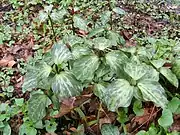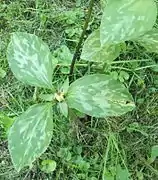Trillium recurvatum
Trillium recurvatum, the prairie trillium,[3] toadshade,[4][5] or bloody butcher,[6] is a species of perennial herbaceous flowering plant in the family Melanthiaceae.[3][6] It is native to parts of central and eastern United States, where it is found from Iowa south to Texas and east to North Carolina and Pennsylvania.[6][7] It grows in mesic forests and savannas, often in calcareous soils.[8][9] It is also known as bloody noses,[3] red trillium,[4] prairie wake-robin,[5] purple trillium,[10] and reflexed trillium,[11] in reference to its reflexed sepals.[11][10]
| Trillium recurvatum | |
|---|---|
 | |
| In Little Rock, Arkansas, showing recurved sepals | |
| Scientific classification | |
| Kingdom: | Plantae |
| Clade: | Tracheophytes |
| Clade: | Angiosperms |
| Clade: | Monocots |
| Order: | Liliales |
| Family: | Melanthiaceae |
| Genus: | Trillium |
| Species: | T. recurvatum |
| Binomial name | |
| Trillium recurvatum | |
| Synonyms[2] | |
| |
Description
Trillium recurvatum grows up to 40 cm (16 in) tall with three ovate to lanceolate bracts, mottled green, 6 to 18 cm (2 to 7 in) long and 2 to 6.5 cm (1 to 3 in) across, petiolate at maturity.[3][10]
The flower has three brown to maroon petals that are 1.8 to 4.8 cm (1 to 2 in) long and 0.9 to 2 cm (0 to 1 in) across, with the petal tips arching over the stamens.[3][10] The sepals are recurved, pointing downwards when the flower has fully opened. The anthers are also dark purple, up to 16 mm (1 in) long.[12] The stigmas are recurved at the tips.[12] It is distinguished from other sessile-flowered Trillium species, such as Trillium sessile, by its reflexed sepals.[10]
The fruit is green, sometimes streaked with purple or white, with six well-developed ridges.[12] The seeds have an oil-rich structure called an elaiosome, which promotes dispersal by ants and other foraging insects.
 A population in the early stages of flowering, still in bud
A population in the early stages of flowering, still in bud An individual with mature fruit, late in the summer
An individual with mature fruit, late in the summer Fruits and seeds
Fruits and seeds.jpg.webp) An unusual individual with four leaves
An unusual individual with four leaves
Conservation
Trillium recurvatum is common throughout much of its range. It is not considered to be globally threatened, and its status is considered secure.[1] However, it is monitored by conservation agencies in several states at the edge of its range, where it becomes rare. For example, in Wisconsin it is considered rare or uncommon (S3) and therefore a species of special concern.[11] In Michigan, it is considered a state threatened species and is protected by law.[4]
References
- "Trillium recurvatum". NatureServe Explorer. NatureServe. Retrieved June 28, 2009.
- Kew World Checklist of Selected Plant Families
- Case Jr., Frederick W. (2002). "Trillium recurvatum". In Flora of North America Editorial Committee (ed.). Flora of North America North of Mexico (FNA). 26. New York and Oxford. Retrieved 19 April 2020 – via eFloras.org, Missouri Botanical Garden, St. Louis, MO & Harvard University Herbaria, Cambridge, MA.
- Trillium recurvatum, Michigan Natural Features Inventory, Lansing. (PDF)
- "Plant Details: Trillium recurvatum". North Carolina Native Plant Society. Retrieved 19 April 2020.
- "Trillium recurvatum". Natural Resources Conservation Service PLANTS Database. USDA. Retrieved 15 December 2015.
- Trillium recurvatum web page from Vanderbilt Bioimages
- "Flora of the Southern and Mid-Atlantic States".
- "Prairie Trillium (Trillium recurvatum recurvatum)". www.illinoiswildflowers.info. Retrieved 19 April 2020.
- Tenaglia, Dan. "Trillium recurvatum L.C. Beck, Purple Trillium". www.missouriplants.com. Retrieved 19 April 2020.
- Reflexed Trillium (Trillium revurvatum), Endangered Resources Program Species Information, Wisconsin Department of Natural Resources.
- Wilhelm, Gerould; Rericha, Laura (2017). Flora of the Chicago Region: A Floristic and Ecological Synthesis. Indiana Academy of Sciences.
